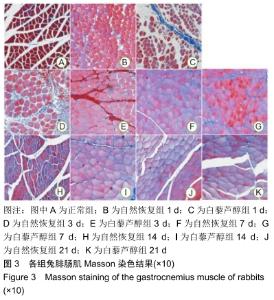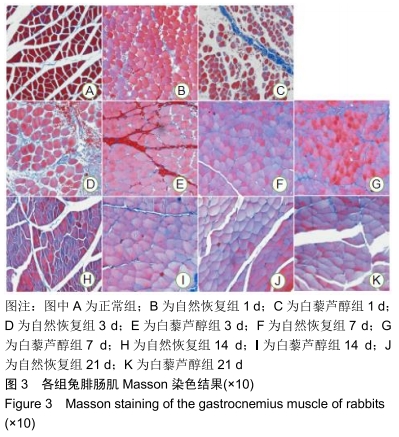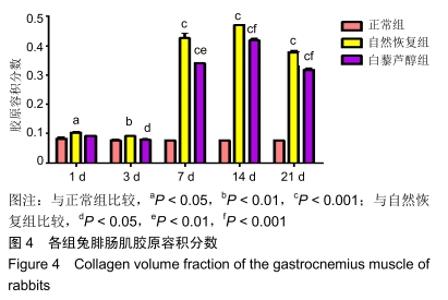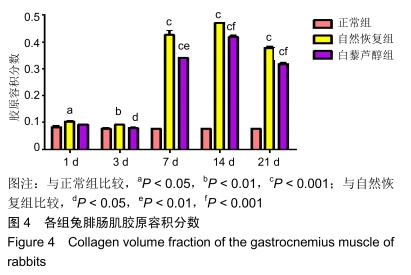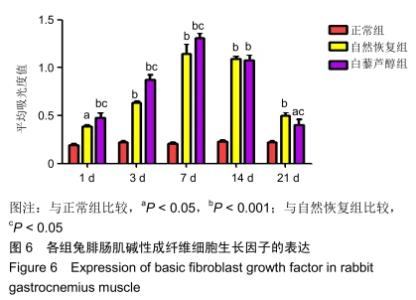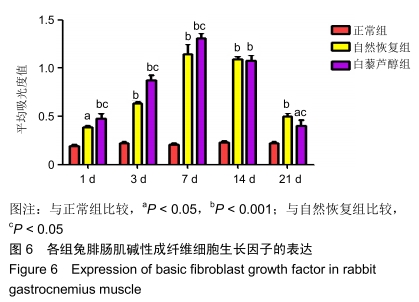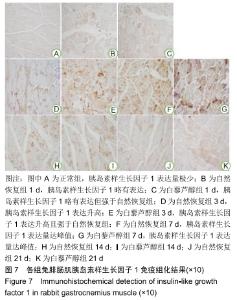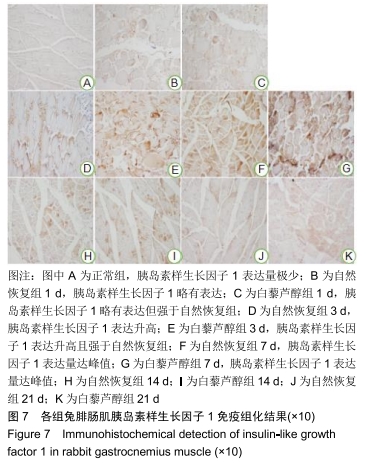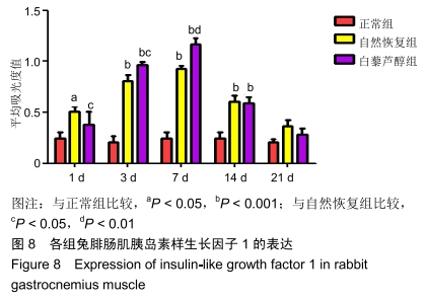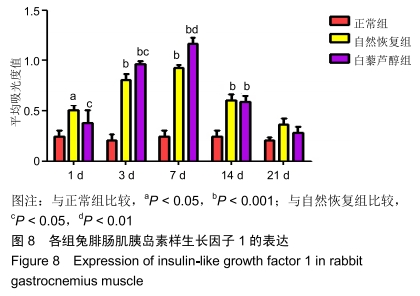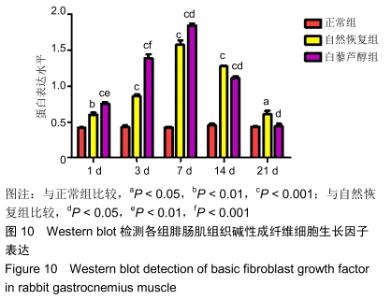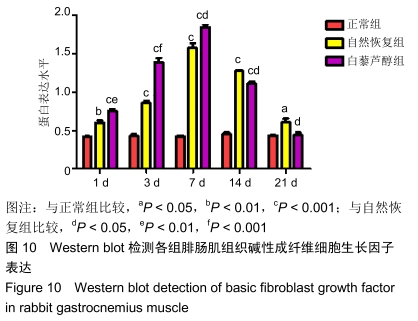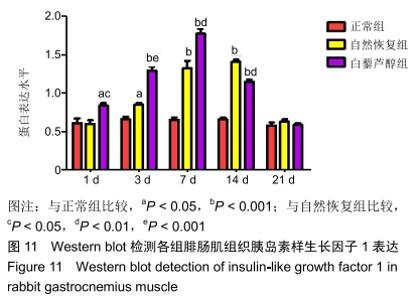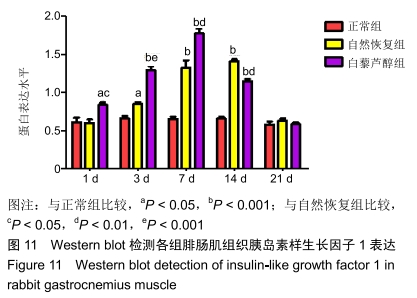Chinese Journal of Tissue Engineering Research ›› 2020, Vol. 24 ›› Issue (14): 2184-2191.doi: 10.3969/j.issn.2095-4344.2533
Previous Articles Next Articles
Resveratrol repairs skeletal muscle injury by up-regulating basic fibroblast growth factor and insulin-like growth factor 1
Liu Xing, Wei Xiaohan, Deng Jie, Li Zhongming
- Department of Human Anatomy and Histology and Embryology, School of Basic Medical Sciences, Kunming Medical University, Kunming 650031, Yunnan Province, China
-
Received:2019-07-15Revised:2019-07-17Accepted:2019-08-19Online:2020-05-18Published:2020-03-15 -
Contact:Li Zhongming, Master, Assoicate professor, Master’s supervisor, Department of Human Anatomy and Histology and Embryology, School of Basic Medical Sciences, Kunming Medical University, Kunming 650031, Yunnan Province, China -
About author:Liu Xing, Master candidate, Department of Human Anatomy and Histology and Embryology, School of Basic Medical Sciences, Kunming Medical University, Kunming 650031, Yunnan Province, China -
Supported by:the Basic Research for Application of Department of Science and Technology of Yunnan Province, No. 2017FE468(-189)
CLC Number:
Cite this article
Liu Xing, Wei Xiaohan, Deng Jie, Li Zhongming. Resveratrol repairs skeletal muscle injury by up-regulating basic fibroblast growth factor and insulin-like growth factor 1 [J]. Chinese Journal of Tissue Engineering Research, 2020, 24(14): 2184-2191.
share this article
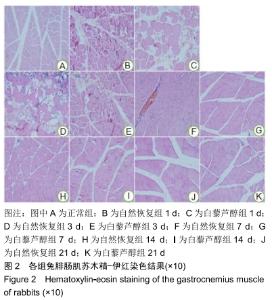
2.1 实验动物数量分析 实验用新西兰兔33只,全部造模成功,中途无死亡,无丢失,均进入数据分析。 2.2 急性钝挫伤模型建立 骨骼肌急性钝挫伤后,各模型组动物均出现行动受限,1 min驱赶移动未超出1 m2,远低于正常组动物25 m2之活动区域。各造模组动物损伤部位均有发热淤青表现,伤后1 h损伤区域肿胀程度开始增大,12 h达到最大,72 h后恢复。预实验解剖结果显示,骨骼肌损伤较严重,但未出现骨折现象,证实造模成功率为100%。 2.3 苏木精-伊红染色结果 见图2。正常组肌纤维为多边形,形态较规则,排列紧密;肌细胞核均匀分布于肌膜下,没有增生以及核固缩,肌膜完整性较好,未见水肿、充血、炎性细胞浸润等病理性变化。骨骼肌损伤后1 d各干预组可见肌纤维水肿,细胞间隙充血严重,肌细胞形态表现为圆形、面积增大,并有少量炎性细胞浸润;骨骼肌损伤后3 d各干预组有大量炎症细胞浸润,血管周围肌纤维溶解并存,部分胞浆完全被巨噬细胞浸润,白藜芦醇组炎症细胞少于自然恢复组;骨骼肌损伤后7 d各干预组炎性细胞逐渐减少,肌间隙充血消失,肌纤维水肿减轻,白藜芦醇组恢复优于自然恢复组;骨骼肌损伤后21 d各干预组逐渐恢复,炎症细胞几乎消失,可见再生肌纤维,中心核,白藜芦醇组优于自然恢复组,但仍不如正常组。骨骼肌损伤后白藜芦醇组恢复整体优于自然恢复组。 "
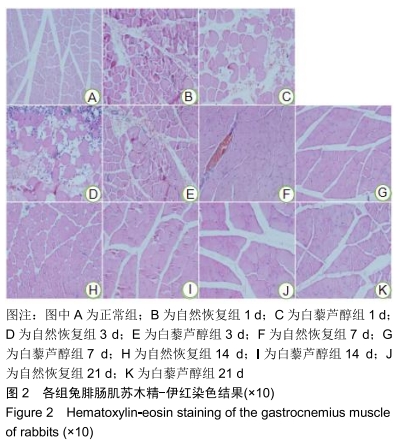
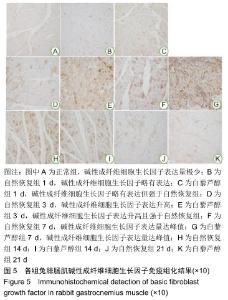
2.5 免疫组化染色结果 碱性成纤维细胞生长因子、胰岛素样生长因子1蛋白阴性染色结果为胞浆或细胞膜不着色,弱阳性表现为细胞胞浆内颗粒较细小,颜色呈现为淡黄色,其显色高于背景色,阳性染色结果表现为细胞胞浆和胞膜着色,颜色为黄色或棕色以及棕黄色颗粒,强阳性表现为胞浆内阳性颗粒多,呈现棕色甚至为棕褐色,其显色明显高于背景色。 通过Image-ProPlus8.0图像分析系统对两组蛋白含量变化进行分析:①骨骼肌损伤后,自然恢复组、白藜芦醇组碱性成纤维细胞生长因子、胰岛素样生长因子1蛋白含量整体呈现先升后降趋势,但21 d时碱性成纤维细胞生长因子、胰岛素样生长因子1蛋白含量仍高于正常组,差异有显著性意义(P < 0.05);②白藜芦醇组和自然恢复组均于7 d达峰值,但白藜芦醇组峰值高于自然恢复组,白藜芦醇组整体优于自然恢复组,差异有显著性意义(P < 0.05),见图5-8。 "
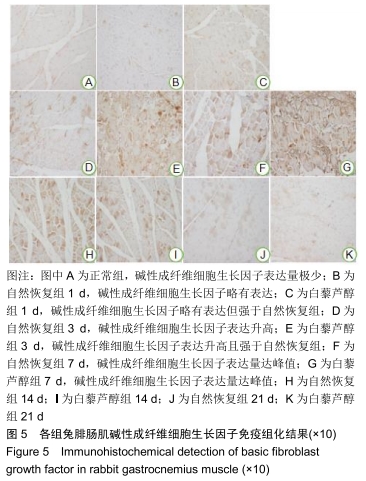
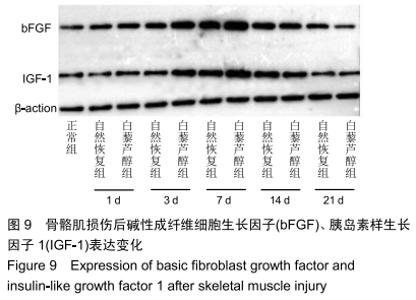
2.6 Western blot检测结果 通过Image-J图像分析软件对碱性成纤维细胞生长因子、胰岛素样生长因子1蛋白表达变化进行分析,结果显示:①骨骼肌损伤后,碱性成纤维细胞生长因子、胰岛素样生长因子1蛋白浓度整体呈现先升后降趋势,差异有显著性意义(P < 0.05);②损伤后1,3,7 d,白藜芦醇组碱性成纤维细胞生长因子、胰岛素样生长因子1蛋白表达均高于正常组,差异有显著性意义(P < 0.05),损伤后14 d白藜芦醇组碱性成纤维细胞生长因子、胰岛素样生长因子1蛋白表达开始低于自然恢复组,差异有显著性意义(P < 0.05),损伤后21 d,自然修复组碱性成纤维细胞生长因子蛋白表达仍高于正常组和白藜芦醇组,差异有显著性意义(P < 0.05);而白藜芦醇组与正常组类似,差异无显著性意义(P > 0.05)。自然恢复组胰岛素样生长因子1蛋白表达与白藜芦醇组相似,差异无显著性意义(P > 0.05),见图9-11。 "
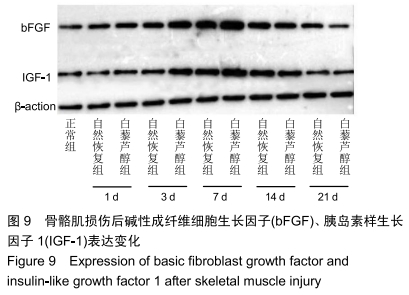
| [1] SATO EJ, KILLIAN ML, CHOI AJ, et al. Architectural and biochemical adaptations in skeletal muscle and bone following rotator cuff injury in a rat model. J Bone Joint Surg Am. 2015;97(7):565-573. [2] HUARD J, LI Y, PENG H, et al. Gene therapy and tissue engineering for sports medicine. J Gene Med. 2003;5(2): 93-108. [3] FENG F, SHAN L, DENG JX, et al. Role of the Notch Signaling Pathway in Fibrosis of Denervated Skeletal Muscle. Curr Med Sci. 2019;39(3):419-425. [4] HUARD J, LI Y, FU FH. Muscle injuries and repair: current trends in research. J Bone Joint Surg Am. 2002;84(5): 822-832. [5] ZUO Q, WANG SC, YU XK, et al. Response of macrophages in rat skeletal muscle after eccentric exercise. Chin J Traumatol. 2018;21(2):88-95. [6] EKBLOM J, GARPENSTRAND H, TOTTMAR O, et al. A cell culture model of cerebral ischemia as a convenient system to screen for neuroprotective drugs. J Neural Transm Suppl. 1998;52:93-98. [7] ALLEN DL, TEITELBAUM DH, KURACHI K. Growth factor stimulation of matrix metalloproteinase expression and myoblast migration and invasion in vitro. Am J Physiol Cell Physiol. 2003;284(4):C805-815. [8] SHI H, XIE H, ZHAO Y, et al. Myoprotective effects of bFGF on skeletal muscle injury in pressure-related deep tissue injury in rats. Burns Trauma. 2016;4:26. [9] VASSILAKOS G, PHILIPPOU A, KOUTSILIERIS M. Identification of the IGF-1 processing product human Ec/rodent Eb peptide in various tissues: Evidence for its differential regulation after exercise-induced muscle damage in humans. Growth Horm IGF Res. 2017;32:22-28. [10] ASCENZI F, BARBERI L, DOBROWOLNY G, et al. Effects of IGF-1 isoforms on muscle growth and sarcopenia. Aging Cell. 2019;18(3):e12954. [11] TIAN F, WANG Y, BIKLE DD. IGF-1 signaling mediated cell-specific skeletal mechano-transduction. J Orthop Res. 2018;36(2):576-583. [12] WANG HW, SUN K, GUAN YX, et al. Fungal endophyte Phomopsis liquidambari biodegrades soil resveratrol: a potential allelochemical in peanut monocropping systems. J Sci Food Agric. 2019;99(13):5899-5909. [13] DIRKS NAYLOR AJ. Cellular effects of resveratrol in skeletal muscle. Life Sci. 2009;84(19-20):637-640. [14] HOWITZ KT, BITTERMAN KJ, COHEN HY, et al. Small molecule activators of sirtuins extend Saccharomyces cerevisiae lifespan. Nature. 2003;425(6954):191-196. [15] HAO L, SCOTT S, ABBASI M, et al. Beneficial Metabolic Effects of Mirabegron In Vitro and in High-Fat Diet-Induced Obese Mice. J Pharmacol Exp Ther. 2019;369(3):419-427. [16] ŞAHIN TD, GÖÇMEZ SS, ERALDEMIR FC, et al. Anxiolytic-Like and Antidepressant-Like Effects of Resveratrol in Streptozotocin-Induced Diabetic Rats. Noro Psikiyatr Ars. 2019;56(2):144-149. [17] CHEN TS, JU DT, DAY CH, et al. Protective effect of autologous transplantation of resveratrol preconditioned adipose-derived stem cells in the treatment of diabetic liver dysfunction in rat model. J Tissue Eng Regen Med. 2019; 13(9):1629-1640. [18] 万荣,伍建业,刘珺,等.白黎芦醇对肝纤维化大鼠肝组织E-钙粘附素表达的干预作用[J].实用肝脏病杂志,2009,12(5):335-338. [19] BECHMANN LP, ZAHN D, GIESELER RK, et al. Resveratrol amplifies profibrogenic effects of free fatty acids on human hepatic stellate cells. Hepatol Res. 2009;39(6):601-608. [20] SALOMÃO RAS, DE PAULA TG, ZANELLA BTT, et al. The combination of resveratrol and exercise enhances muscle growth characteristics in pacu (Piaractus mesopotamicus). Comp Biochem Physiol A Mol Integr Physiol. 2019;235:46-55. [21] 刘洪柏,区丽明.富血小板血浆联合转化生长因子-β1抗体对大鼠骨骼肌损伤修复的研究[J].生物医学工程与临床, 2018,22(2): 187-190. [22] TIDBALL JG, VILLALTA SA. Regulatory interactions between muscle and the immune system during muscle regeneration. Am J Physiol Regul Integr Comp Physiol. 2010;298(5): R1173-1187. [23] 尚画雨,白胜超,夏志,等.针刺对大负荷运动大鼠骨骼肌线粒体结构和功能的影响[J].中国康复医学杂志,2018,33(8):901-909. [24] WU C, TANG L, NI X, et al. Salidroside Attenuates Denervation-Induced Skeletal Muscle Atrophy Through Negative Regulation of Pro-inflammatory Cytokine. Front Physiol. 2019;10:665. [25] HAN WM, MOHIUDDIN M, ANDERSON SE, et al. Co-delivery of Wnt7a and muscle stem cells using synthetic bioadhesive hydrogel enhances murine muscle regeneration and cell migration during engraftment. Acta Biomater. 2019; 94:243-252. [26] 张安宁,罗雪林,黄思琴,等.PI3K/Akt/mTOR信号通路在大鼠急性骨骼肌钝挫伤修复中的作用[J].中国运动医学杂志, 2018,37(7): 594-600. [27] KANEKO M, TSUJI T, KISHIMOTO Y, et al. Regenerative Effects of Basic Fibroblast Growth Factor on Restoration of Thyroarytenoid Muscle Atrophy Caused by Recurrent Laryngeal Nerve Transection. J Voice. 2018;32(6):645-651. [28] BAKER HB, PASSIPIERI JA, SIRIWARDANE M, et al. Cell and Growth Factor-Loaded Keratin Hydrogels for Treatment of Volumetric Muscle Loss in a Mouse Model. Tissue Eng Part A. 2017;23(11-12):572-584. [29] SHI H, XIE H, ZHAO Y, et al. Myoprotective effects of bFGF on skeletal muscle injury in pressure-related deep tissue injury in rats. Burns Trauma. 2016;4:26. [30] 刘仁建.按摩对损伤骨骼肌生长因子bFGF、IGF-Ⅰ及致瘢痕因子TGF-β1、COL-Ⅰ的影响研究[D].重庆:重庆医科大学,2013. [31] 刘晓光,徐苗苗,陈佩杰,等.IGF-1在治疗骨骼肌损伤中的应用潜能及其相关机制[J].生命的化学,2016,36(4):496-502. [32] HURME T, KALIMO H, SANDBERG M, et al. Localization of type I and III collagen and fibronectin production in injured gastrocnemius muscle. Lab Invest. 1991;64(1):76-84. [33] HUARD J, LI Y, FU FH. Muscle injuries and repair: current trends in research. J Bone Joint Surg Am. 2002;84(5): 822-832. |
| [1] |
Xiang Haidong, Cheng Dongmei, Guo Han, Gao Qi .
Changes in the proliferation and angiogenesis of human dental pulp stem cells after treated with prostaglandin E1 combined with basic fibroblast growth factor [J]. Chinese Journal of Tissue Engineering Research, 2020, 24(25): 4006-4011. |
| [2] | Yang Fan, Liu Baoyi, Cao Meng, Zhu Xiaoshu, Zhang Yu, Qin Kairong, Zhao Dewei. Basic fibroblast growth factors protect chondrocytes by antagonizing extracellular inflammatory factors [J]. Chinese Journal of Tissue Engineering Research, 2020, 24(23): 3621-3626. |
| [3] | Li Hong, Wu Shaohua, Qiu Mingxing, Deng Qingfu, Lei Guolin, Li Qinglong. Mechanism underlying basic fibroblast growth factor and insulin-like growth factor-1 effects on proliferation and apoptosis of spermatogonial stem cells [J]. Chinese Journal of Tissue Engineering Research, 2020, 24(19): 3017-3022. |
| [4] | Dong Wentao, Zhou Yongfang, Zhang Jian, Zhang Fei, Wu Jianhua, Wang Qiang, Xu Fengyang, Peng Wuxun. Treatment of steroid-induced femoral head necrosis by hypoxia-induced bone marrow stromal stem cell transplantation [J]. Chinese Journal of Tissue Engineering Research, 2019, 23(33): 5307-5311. |
| [5] | Sang Peng, Liu Yi. Scleraxis combined with basic fibroblast growth factor promotes the differentiation of human amniotic mesenchymal stem cells into human ligament fibroblasts in vitro [J]. Chinese Journal of Tissue Engineering Research, 2019, 23(29): 4644-4650. |
| [6] | Zhu Xu, Shen Jun, Yang Rongkun, Wang Yong, Liu Yang, Sun Quan, He Zhuying, Chen Jiuyi. Mechanism of traditional Chinese medicine Shixiang plaster in promoting the repair of soft tissue defects [J]. Chinese Journal of Tissue Engineering Research, 2019, 23(27): 4350-4355. |
| [7] | Liu Wenhua, Liang Jinfeng, Deng Shaojie. Resveratrol reduces tumor nuclear factor-α expression in wear-particle-treated macrophages by regulating the level of intracellular oxidative stress [J]. Chinese Journal of Tissue Engineering Research, 2019, 23(26): 4115-4120. |
| [8] | Wang Tong, Liu Yang, Zhu Yetao. Combined use of exogenous nerve growth factor and basic fibroblast growth factor promotes proliferation of endogenous brain cells in a rat model of severe traumatic brain injury [J]. Chinese Journal of Tissue Engineering Research, 2019, 23(25): 3998-4003. |
| [9] | Wu Huala, Zhou Xiangxiang, Zhong Yulan, Gan Xin. Basic fibroblast growth factor-transfected bone marrow mesenchymal stem cell transplantation for chronic obstructive pulmonary disease [J]. Chinese Journal of Tissue Engineering Research, 2019, 23(21): 3378-3385. |
| [10] | Wang Xiao-zhi, Yang Hua, Zhang Chen, He Hui-yu, Ba Jiao-jiao. Bone defect repair using allogenic bone carrying bone morphogenetic protein-2 and gene transfected bone marrow mesenchymal stem cells [J]. Chinese Journal of Tissue Engineering Research, 2018, 22(9): 1313-1318. |
| [11] | Wang Yu1, Guo Tian-kang2, Liu Jing3, Yang Rui-fei3, Shao Fei-fei3, Tian Li-min3. Association of insulin-like growth factor 1 receptor gene rs2229765 polymorphism with osteoporosis in postmenopausal women [J]. Chinese Journal of Tissue Engineering Research, 2017, 21(12): 1813-1818. |
| [12] | Xue Ling-fa, Xu Yao-xiang, Yue Jin, Wang Shuang-yi, Xiao Wen-lin, Zhang Chun-yang. Recombinant bovine basic fibroblast growth factor gel prevents dry socket syndrome after toothextraction [J]. Chinese Journal of Tissue Engineering Research, 2013, 17(34): 6097-6102. |
| [13] | Wei Li, Jiang Li-ting, Zhou Qi, Zhu Ya-ping, Gao Yi-ming. Insulin-like growth factor 1 affects the apoptosis of rat condylar chondrocytes [J]. Chinese Journal of Tissue Engineering Research, 2013, 17(33): 5901-5908. |
| [14] | Zhao Jia-jia, Hu Li, Liu Jia-rong, Gong Ni-ya, Chen Li-li. Adipose stem cell-derived growth factors and proliferation of oral mucosa fibroblasts [J]. Chinese Journal of Tissue Engineering Research, 2013, 17(32): 5778-5784. |
| [15] | Zhang Kai-wei, Duan Hong, Xiang Zhou, Xiao Rui, Chen Jiu-yi. Combination of Schwann cells, small intestinal submucosa and growth factor sustained-release microspheres for repair of peripheral nerve defects [J]. Chinese Journal of Tissue Engineering Research, 2013, 17(3): 457-464. |
| Viewed | ||||||
|
Full text |
|
|||||
|
Abstract |
|
|||||
